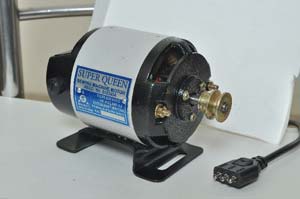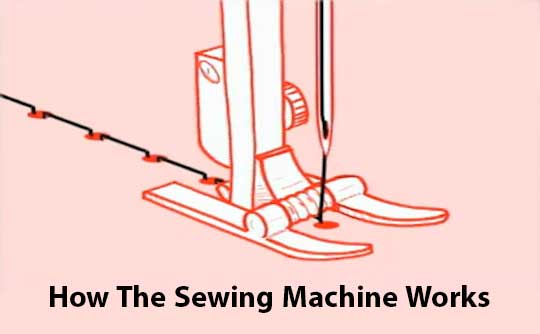How The Sewing Machine Works: The Definitive Guide
You have probably at one time or another needed to do some repair to a clothing item. The process is quite simple to learn. It is, however, the capability of the machine and how it can perform the same task is quite a lot to process.
Most users may well maintain their machines and service them on time but do not really care or want to know how it works.
The sewing machine traces its roots to the 19th century in Australia when a tailor, Josef Madersperger began working on his first sewing machine in 1807 and took seven years to get it working.
However, the first sewing machine to be used in the setting we know was developed in 1829 by a French tailor, Barthélemy Thimonnier.
Table of Contents
So How Does It Work?
Looking at the normal hand-stitching technique, it is hard to process how the sewing machine performs the same function. All the eye can see is the needle moving up and down. And, down to an unknown place but makes a stitch all the same.
So, we are going to demystify in the simplest way possible how the sewing machine works.
First of all, you will need to learn the various components that form the working mechanism of the sewing machine. It is these parts that work together to form the stitches.
Needle
This is the working part that is easily visible to the eye. What we see is the needle moving up and down while drawing the thread and making stitches. We will get to the stitches later.
The needle used on a sewing machine is different from the conventional needle used for hand stitching because the eye, in this case, is located at near the sharp end of the needle. It is the opposite for a normal needle that has got the eye at the back of the needle.
Spool Pin
The spool pin holds the small roll of thread and allows it to roll freely releasing the thread through one or two guiding mechanisms and finally to the needle.
Thread take-up is the first control mechanism that the thread goes through. It is located at the opposite end of the machine from where the spool is located.
Thread Take-Up Mechanism
This pulls the thread from the spool giving a smooth flow to the thread guide. The thread loops head back to the take-up mechanism.
And, this time the function is to pull the thread after the needle has made a stitch to fasten it. It moves in horizontal motions to perform this function.
The Thread Guide
This takes up the thread from the take-up mechanism and guides it to the needle.
Needle
This is the piercing part of the sewing machine that has an eye through which the thread passes. It pierces the fabric drawing the thread through to make the stitch.
Press Foot
The press foot is shaped like a foot hence the name. The shape is to allow the thread to pass between its ‘toes.’ This is what holds down the fabric in place as you stitch.
Press Foot Lifter
This is the controlling mechanism of the press foot. It is used to control just how firmly the press foot is holding the fabric. Different sewing techniques need specified room to function.
Feed Dogs
These look like teeth and are used to ‘feed’ or move the fabric in the direction of the stitching.
Bobbin Box
This is a small compartment located just under the press foot and needle that houses the bobbin.
Bobbin
This is a small wheel on which thread from the spool winds.
Bobbin Winder Spindle
The Bobbin winder spindle winds the thread from the spool to the bobbin mechanically using the Bobbin Winder.
The Bobbin Winder
This is a winding mechanism located at the top of the sewing machine next to the spool on the outer side. It is used to keep the bobbin winding as stitching goes on to wind thread from the spool.
The Hand Wheel
It is used to manually lift the needle up and down.
Stitch Width Control
Used to control how wide the stitches are.
Stitch Length Control
It is used to regulate the length of the stitches.
Reverse Lever
This lever reverses the direction of the stitching making the feed dog move the fabric in the opposite direction.
The Foot Pedal
It can be manual or automatic.
The manual foot pedal is rare but is used to mechanically operate the crankshaft functions that control the needle motion and the dog feeds.
It functions when a tailor uses his or her feet to move it back and forth in a seesaw kind of motion. An automatic pedal simply requires a little pressure to power the electric motor that performs the same functions.
Older machines had the function operated by a hand lever but were not as convenient as one hand was always occupied leaving only one to move the fabric as it stitches.
The Electric Motor

This is a very important component of the sewing machine that controls the movable functions of the sewing machine. These movements are carefully timed to perform certain movements at certain stages of the sewing.
How It Works
Now the aim of all these controls is to take the thread from the spool and guide it to make a stitch.
Let’s go step by step until we make a stitch. This is what happens in one cycle of the sewing machine:
- 1The thread leaves the spool and passes through the thread take up and to the thread guide.
- 2It is then guided into the needle eye; you will have to thread the needle manually yourself from the thread guide.
- 3The needle which is moved up and down by a crankshaft makes a piercing through the piece of fabric drawing through the strand of thread. The fabric is secured in place by the presser foot and one of the feed dogs.
- 4The other feed dog gets ready to move the fabric to the required distance to make the stitch.
- 5In the meantime, the thread is picked up below by a hook rotating at a calculated speed and is intertwined with another strand before the needle lifts it out again of the fabric. This intertwining is actually what makes the stitch.
This function of making the stitch can be regulated in terms of length and width using the stitch length and stitch width regulators respectively.
Most current models of sewing machines also consist of features that allow you to make different kinds of stitches. This is done by manipulating the strand of thread further to make different desired patterns; that is a subject for another day.
The speed of the process can also be regulated using the motor speed levels or by the pace of peddling in the case of a manual pedal.
Frequently Asked Questions (FAQs)
1. What did the first sewing machine do?
The first sewing machine for American was made by Elias Howe in September 10, 1846. It was used at a factory to fix clothes and also on production lines. After the invention of this machine, it was used in a wide scale for making blankets and clothing. It made the whole process of sewing much faster and easier.
2. How much did the first sewing machine cost?
If you look at the history of the first American sewing machine, the price for buying one of them would cost around $125. In today’s currency the price is around $3470. In this day and age, you can find sewing machines from below $100 and all the way up to $12k.
3. Why Elias Howe invented the sewing machine?
Elias Howe is inventor of the world’s first successful and practical sewing machine. He was also the very first person to patent the lockstitch sewing machine. It was one of its kind and this invention revolutionized the garment industry. His sewing process was much faster.
4. What are the types of sewing machine?
In general, sewing machines can be divided into 5 types.
It was categorized based on their sewing features, functionality, quilting and embroidery.
Final Thoughts
At present, sewing machines are an essential tool in our clothing and shoe industry. Thanks to modern technology, this machine is widely available in factories as well as in your homes. You can easily learn this process and just knowing the basics is enough to get started.
New sewing machines are more advanced and feature rich. They can do more than just sewing clothes. It’s easy to get started, and you can make small gifts for your little ones to wear at the comfort of your home.

